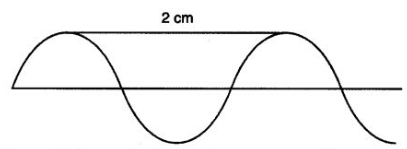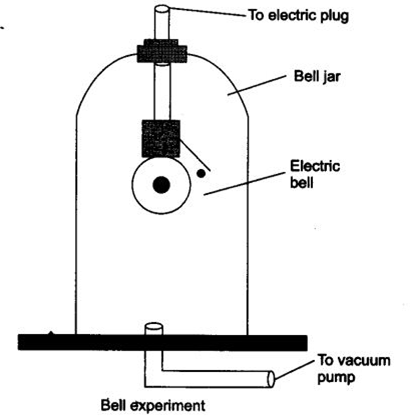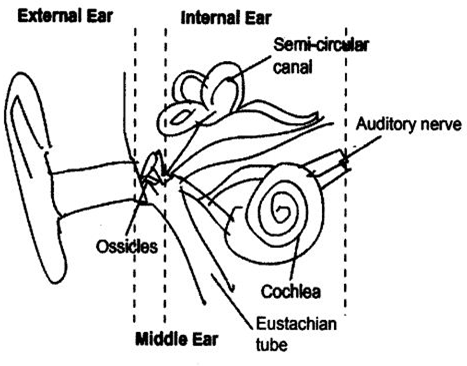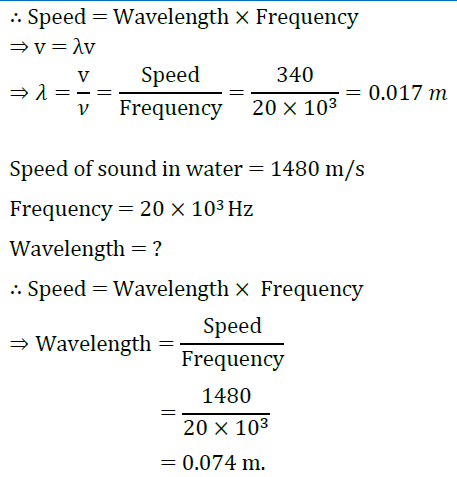Extra Questions for Class 9 Science Chapter 12 Sound
Extra questions for Class 9 Science Chapter 12 Sound with answers is given below. Our subject expert prepared these solutions as per the latest NCERT textbook. These questions will be helpful to revise the all topics and concepts. CBSE Class 9 extra questions are the most simple and conceptual questions that are prepared by subject experts for the students to study well for the final exams. By solving these extra questions, students can be very efficient in their exam preparations.
Sound Class 9 Science Extra Questions and Answers
Very Short Answer Questions
1: Is sound wave longitudinal or transverse?
Answer: Sound wave is longitudinal in nature.
2: What is the relation between frequency (v) and time period of a sound wave?
Answer: v = 1/T
Frequency is inversely proportional to time period.
3: In which of the three media air, water or steel does sound travel the fastest?
Answer: Sound travels fastest in steel.
4: Which has a higher pitch—the sound of a whistle or that of a drum?
Answer: The sound of whistle has higher pitch.
5: What is pitch?
Answer: The way our brain interprets the frequency of an emitted sound is called the pitch.
6: How can we distinguish one sound from another having the same pitch and loudness?
Answer: The quality or timber of sound helps us to distinguish one sound from another having the same pitch and loudness.
7: What is the audible range of frequency for human beings?
Answer: The audible range of frequencies for human beings is 20 Hz to 20,000 Hz.
8: What is one Hz?
Answer: Hz is the unit of frequency, called as Hertz. One Hertz is equal to one cycle per second.
9: Define speed of sound.
Answer: The speed of sound is defined as the distance travelled per unit time by compression or rarefaction.
10: What is ‘note’ of sound?
Answer: The sound produced due to a mixture of several frequencies is called a note, it is pleasant to listen to.
11: Find the frequency of a wave whose time period is 0.002 second.
Answer: Frequency = 1/ Time period
Frequency = 1/0.002 = 500 Hz
12: What is the time period-of sound wave?
Answer: The time taken by two consecutive compressions or rarefactions to cross a fixed points is called the time period of the wave.
13: What is the minimum distance required to hear distinct echo?
Answer: The minimum distance of the obstacle from the source of sound should be 17.2 m.
14: What is reverberation?
Answer: The repeated reflection that results in the persistence of sound is called reverberation.
15: What is SONAR?
Answer: SONAR is—Sound Navigation and Ranging. It is a device that uses ultrasonic waves to measure the distance, direction and speed of underwater objects by getting the reflection of sound.
16: What is ‘ultrasonic’ and ‘infrasonic’ sound wave?
Answer: Sound waves with frequencies below the audible range (less than 20 Hz) are termed as “infrasonic” and those sound waves with frequencies above the audible range (more than 20000 Hz) are termed as “ultrasonic”.
17: What should be the time interval between the originated sound and the reflected sound to be heard distinctly?
Answer: To hear a distinct sound the time interval between the originated sound and the reflected sound must be at least 0.1 second.
Short Answer Type Questions
1: What is a medium? Give two examples.
Answer: The matter or substance through which sound is transmitted is called a medium. It can be solid, liquid or gas. Example, air, water, metals.
2: Define wave-motion.
Answer: A wave is a disturbance that moves through a medium when the particles of the medium set neighbouring particles into motion. The particles of the medium do not move forward but the disturbance is carried forward.
3: What is ‘sonic boom’?
Answer: When an object just attains a supersonic speed, it causes shock waves in air. As a result there is large change in air pressure. This results in sonic boom.
4: Why does sound become faint with distance?
Answer: Sound is a form of energy. As it moves away from the source its amplitude as well as its loudness decreases. The energy also get transformed in vibration of the particles of the medium.
5: Why do we say that sound waves are longitudinal?
Answer: Longitudinal waves need medium for propagation. The sound energy travel in the same line as the particles oscillate. It forms compression and rarefaction for the longitudinal wave motion. Sound wave shows all the characteristics of longitudinal wave so it is called as longitudinal wave.
6: Differentiate between longitudinal wave and transverse wave.
Answer:
| Longitudinal Wave | Transverse Wave |
| It needs medium for propagation. | It may or may not need medium for propagation. |
| Particles of the medium move in a direction parallel to the direction of propagation of the disturbance. Example, sound wave. | Particles of the medium move in perpendicular direction of propagation of the disturbance. Example, light wave seismic wave. |
7: What is crest and trough?
Answer: When a wave is propagated as represented below. A peak is called the crest and a valley is called the trough of a wave.

8: The maximum oscillation disturbance of particles of air forms crest and trough. What is echo? Why don’t we get echo in small room?
Answer: The distinct sound heard after reflection of sound from the source is called echo. For echo, the distance of reflecting surface from the source should be more than 17.2 m.
9: What is velocity of sound? Why does sound travel faster in summer season than in winter?
Answer: Velocity of sound is- the speed of sound in a given medium at a given temperature. As the temperature increases the speed of sound also increases, hence in summer the sound travels faster than in winter.
10: Draw a graphical representation of the wave shape for
(a) low pitched sound
(b) a high pitched sound.

11: Give two applications of echo/reflection of sound.
Answer: (i) Ships use reflection of sound technique “SONAR” which helps in locating the depth, distance, direction and speed of underwater objects.
(ii) Ceilings of concert halls are curved so that sound after reflection reaches all comers of the hall.
12: Define amplitude time period and frequency of sound wave.
Answer: Amplitude: The magnitude of the maximum disturbance in the medium on either side of the mean value is called amplitude of the wave. Its unit is meter.
Time Period: The time taken by two consecutive compressions or rarefactions to cross a fixed point is called the time period of the wave.
Frequency: The number of oscillation, occurring per unit time is called the frequency of sound wave.
13: A sound wave causes the density of air at a place to oscillate 1200 times in 2 minutes. Find the time period and frequency of the wave.
Answer: Frequency = 1200/2 × 60 = 10Hz
Time period = ?
Frequency = 1/T
∴ T = 1/Frequency
= 1/10
= 0.1 s.
14: Give 3 uses of ultrasound.
Answer: Use of ultrasound:
1. Ultrasound is used to detect cracks and flaws in metal blocks.
2. It is used in ‘echo-cardiography’, the ultrasonic waves are made to reflect from various parts of the heart and form the image of the heart.
3. It is used in ‘ultrasonography’, to detect the image of organs or to detect the abnormalities in the organs. It is also used to examine the foetus during pregnancy to detect congenital defects.
15: What is the function of middle ear?
Answer: Middle ear consist of three small bones called hammer, anvil and stirrup. These three bones receive the sound vibrations and increase the strength of these vibrations to amplify the vibrations received by ear-drum. These amplified vibrations are furthgr passed to the inner ear.
A ship sends out ultrasound that return from the seabed and is detected after 3.42 s.
16: If the speed of ultrasound through seawater is 1531 m/s. What is the distance of the seabed from the ship?
Answer: Time between transmission and detection t = 342 s.
Speed of ultrasound in seawater = 1531 m/s.
Distance travelled by the ultra sound = 2 × depth of sea = 2d
2d = speed of sound × time
= 1531 × 3.42
= 5236 m
∴ d = 5236/2
= 2618 m.
The distance of the seabed from the ship is 2618 m.
17: Distinguish between tone, note and noise.
Answer: Tone: A sound of single frequency is called a tone.
Note: The sound which is produced due to a mixture of several frequencies is called a note.
Noise: The sound which is produced due to a mixture of several frequencies but is unpleasant to the ear is called noise.
18: Establish the relationship between speed, wavelength and frequency of sound.
Answer: Speed of sound —» The distance travelled by a wave or a point on a wave (compression or rarefaction) per unit time.
Speed v = Distance/Time
v = λ/T
Distance = wavelength of the sound wave, it is the distance travelled by the sound wave in one time period (T) of the wave.
∴ v = λ/T (as v = 1/T)
∴ v = λv,
Frequency = 1/Time period
Speed = Wavelength × Frequency.
19: Which wave property determines
(a) loudness?
(b) pitch?
Name the characteristic of the sound which help you to distinguish your friend’s voice while talking in a dark room.
Answer: (a) Loudness is determined by amplitude.
(b) Pitch is determined by frequency.
The quality or timber of sound helps us to distinguish our friend’s voice while talking in a dark room.
20: A sound produces 13 crests and 15 troughs in 3 seconds. When the second crest is produced the first is 2 cm away from the source? Calculate.
(a) the wavelength
(b) the frequency
(c) the wave speed.
Answer:

(a) Wavelength = distance between two consecutive crests or troughs is 2 cm.
(b) Frequency = Number of troughs/Time = 15/3 = 5 Hz
(c) Wave speed = Distance/Time
Distance travelled by wave = 15 × 2 = 30cm
Time = 3 seconds
∴ Wave speed = 30/3 = 10 cm/s.
Long Answer Type Questions
1: Sound cannot travel in vacuum. Describe an experiment to demonstrate this.
Answer: Sound is a mechanical wave and needs a material medium to propagate. It cannot travel in vacuum and can be shown by the following experiment.
- Take an electric bell and an airtight glass bell jar. The electric bell is suspended inside the airtight bell jar. Switch ‘ON’ the electric bell.
- Now, connect the bell jar to vacuum pump.
- Pump out the air from the jar, the sound becomes fainter, although the same current passes through the bell.
- Pump out some more air from the jar, a very feeble sound is heard.
- When the air is completely removed from the jar, no sound is heard.

2: Explain the structure of the human ear with the help of a diagram.
Answer:

(a) Outer Ear: Pinna, auditory canal and tympanic membrane
Pinna: It collects the sound from the surroundings.
Auditory Canal: The sound waves collected passes through this canal.
Tympanic Membrane: It is a thin membrane which receives the vibrations of sound. A compression reaches the eardrum, the pressure on the outside of the membrane increases and pushes the eardrum inward, and moves out when the rarefaction reaches.
(b) Middle Ear: Consists of three small bones called hammer, anvil and stirrup. The vibrations are received by these three bones and the strength of vibrations is increased i.e., the sound is amplified and passed to inner ear.
(c) Inner Ear: It consist of cochlea and auditory nerve.
Cochlea receives the amplified vibrations and convert them into electrical signals. These electrical signals are sent to the brain via the auditory nerve and the brain interprets the signals as sound.
3: Given that sound travels in air at 340 m/sec, find the wavelength of the waves in air produced by 20 kHz sound source. If the same source is put in a water tank, what would be the wavelength of the sound waves in water? (Speed of sound in water = 1480 m/s.)
Answer: Speed of sound in air = 340 m/s.
Frequency = 20 kHz = 20 × 103 Hz
Wavelength = ?

4: A child watching Dussehra celebration from a distance sees the effigy of Ravana burst into flames and hears the explosion associated with it 2 sec after that. How far was he from the effigy if the speed of sound in air that night was 335 m/sec?
Answer: Speed of sound in air = 335 m/s.
time required to reach the sound = 2 sec
distance of the source of sound = ?
∴ Speed = Distance/Time
∴ Distance = Speed × Time
= 335 × 2 sec
= 670 m.
Value Based Questions
1: Raj noticed that his pet dog was frightened and trying to hide in safe place in his house when some crackers were burst in the neighbourhood. He realized the problem and he decided not to burst crackers during diwali or for any other celebrations.
(a) What must be the range of crackers sound?
(b) Name two diseases that can be caused due to noise pollution.
(c) Name the values of Raj reflected in above act.
Answer: (a) The range of crackers sound must be between 20 Hz to 20 kHz.
(b) Two diseases that can occur due to noise pollution are heart attack and high blood pressure.
(c) Raj reflects the value of respecting sensitivity for animals and caring for animals.
2: It is not advisable to construct houses near airports, in spite of that many new residential apartments are constructed near airports. Sumit files RTI and also complains the municipal office about the same.
(a) Why one should not reside near airport?
(b) Name other two places where there is noise-pollution.
(c) What value of Sumit is reflected in this act?
Answer: (a) The landing and taking off of the air-planes causes lot of noise pollution which may lead to deafness, high blood pressure and other health problems.
(b) The other two places where there is noise-pollution is, residing near the heavy traffic routes and railway stations or lines.
(c) Sumit shows participating citizen and moral responsibility values.